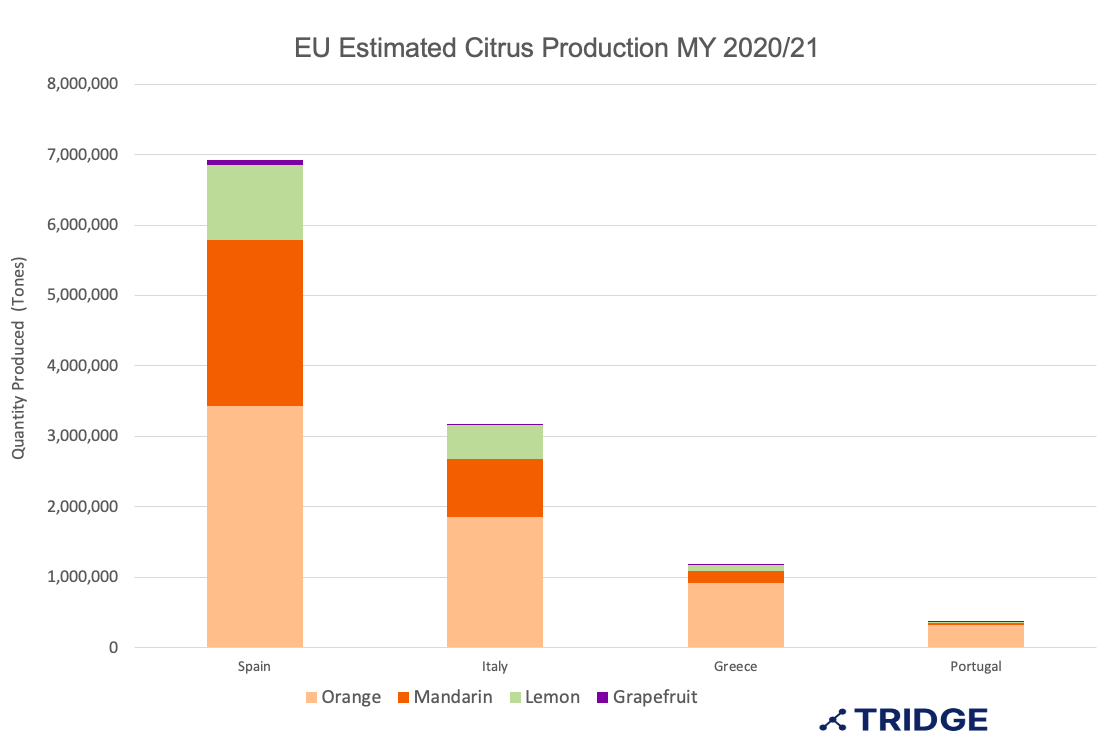Spain to Lead EU Citrus Rebound Production in MY 2020/21
The USDA citrus semi-annual report has projected new and updated estimations from its original citrus annual report. This increase in EU citrus production is 2.65% higher than the previous estimations. Favorable weather conditions through Europe have made the increase in the estimations possible. However, a rebound of production in Spain from last MY 2019/20 is what mainly drives the estimations higher. Within this rebound in the Spanish country, changes in the production areas occurred in recent years that have led Spain to gain larger productivity.
EU Rebound by Citrus Fruit
EU citrus production is mainly concentrated in the Mediterranean region, where Spain and Italy represent most of the EU citrus production, followed by Greece, Portugal, and Cyprus. For MY 2020/21, which goes from October to September, a 10.4% increase in overall production is expected compared to the previous season. Among these countries, Spain shows the most significant increase in all the projected citrus fruits: oranges, mandarins, lemons, and grapefruits.
For oranges, the EU production is forecasted to be 5.2% higher than the previous season, reaching6.5 MMT, but 0.4% lower than previous estimations. This new forecast is mainly due to slightly smaller declines in Spanish orange production than estimated at the beginning of this current season. Spain and Italy represent 80% of the EU’s total production of oranges. For mandarins, the EU production is forecasted to jump 21% from the previous year to 3.4 million MT. The increase is 10% higher than the previous estimations, mainly due to the strong growth in Spanish production.
For lemons, production is forecasted to increase almost 11.7% compared to the previous season to 1,654 million MT and 0.8% higher than the previous estimations. The increase is due to the overall expected production rise in the EU’s main lemon-producing countries except for Portugal. In the case of grapefruit, production is estimated to increase 8% compared to the previous season to 103,000 MT.

Source: ITC Trade Map, Tridge
Over the last ten years, the EU’s total orange and mandarin planted area shrunk while citrus farms have increased productivity, sustainability, and performance. In contrast, the EU’s total lemon and grapefruit planted area continue on an upward trend, mainly in Spain due to global demand growth. In all cases, Spain keeps leading production on all citrus products, while their orange and mandarins planted areas keep shrinking and shifting to a more productive and sustainable model.
A Shift in Spanish Citrus Production
In MY 2019/20, Spain, the leading EU mandarin producer and exporter, decreased its mandarin exports by 13% to 1.3 MMT due to shorter supplies during that season. However, the value of exports grew 10% to USD 1.5 billion, and overall, citrus exports were valued at USD 4 billion.
The main reason behind this is that in Spain, for the last years, there have been notable changes, mainly in the location of citrus production, that have led the country to gain higher value from their citrus products.
Rocio Martín, the CEO of Lionfenix and a citrus expert in Spain, has explained to Tridge that new regions have substantially increased their production. “Valencia is the producing region with the largest citrus acreage, around 60% of the national total, although the relative weight of the acreage in Andalusia is continuously growing and already represents around 20%,” she mentioned. However, Andalucia and Murcia’s regions have been more productive and sustainable than the Valencia region. According to the Ministry of Agriculture of the Junta de Andalucía, Andalucia and Murcia already account for 50% of the total citrus production while accounting for less acreage.
The growth in Andalucia and Murcia has been achieved by royalty-free mandarin varieties, by late oranges, both Navel and new Valencia Late, and by lemons. According to Rocio Martin, Valencia still occupies the first national place in both orange and mandarin, and Murcia in lemon and grapefruit. However, she mentioned, “Valencian citrus production continues to lose weight, although it still represents more than half of the national total, while Andalusia is increasingly increasing its market share.”
Spanish Citrus Industry Outlook
Poor harvests, mainly in the Castellon and Valencia area, have pushed producers to abandon citrus farms of less than 20 hectares, leading to a loss of 43,582 hectares in those regions. For Rocio Martin, it is very clear that the production trend in the country has to do with the search for higher profitability. “The change of production from the Valencian Region to other areas with good weather and water conditions where the larger farms can allow a more sustainable and less expensive exploitation will determine the country’s future output,” she added.
In terms of exports, EU citrus exports may rebound from the higher demand for citrus derived from the COVID-19 pandemic as consumers look for foods to strengthen their immune systems.
Last season, higher consumption combined with lower EU citrus supplies led to spiking citrus prices. However, with an increase in production this season and a sustained dynamic citrus consumption from last year, Spain should be able to increase its exports within its main traditional markets.
Sources:



